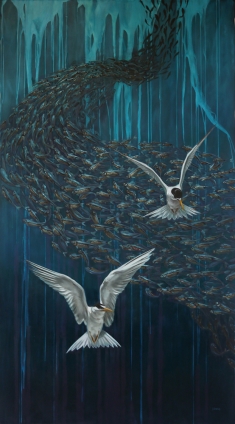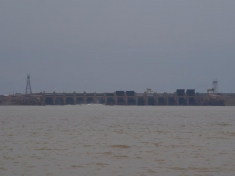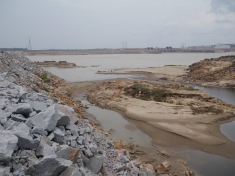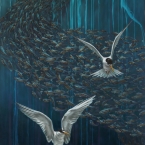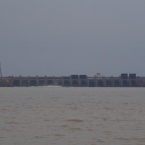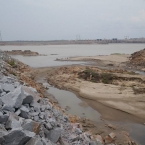Jennifer Downey: The Madeira River
In October of 2012, I stood on the bank of the Madeira River in Brazil and, shading my eyes, stared at the giant Santo Antonio Dam about a mile upstream. Despite the distance, its span of more than 10,000 feet meant it dominated the entire horizon, and I grappled with its scale. Construction had just been completed in March, but the scars on the landscape were fresh. The river, its animals and people were still adjusting to the massive and chaotic change to their environment.
I was midway through a month-long research trip in Brazil to study several dams and learn about the ecosystems of their affected rivers. I’m an artist whose work focuses on dams and river diversions, and how they affect species and ecosystems. For the previous year, I’d been researching the South American dam boom that’s currently underway, led by Brazil. More than 150 large dams are planned for the Amazon basin over the next 20 years, as part of a larger multinational infrastructure scheme meant to generate power and make the basin navigable for ship transportation. Branded as “green energy” projects, these dams are being sold as environmentally responsible and low-impact. However, the negative impacts of large dams—on the river ecosystem and the people who depend on it—are not widely publicized or well-known. I hope, through my artwork, to help raise public awareness on this topic.
From my spot on the bank, I swept my gaze downstream towards the small port and marina about a mile away. I was standing on one of countless large boulders that covered the bank, both sides and top. They’d been brought in to stabilize the bank after construction crews had noticed erosion problems following the dam going fully operational. I continued walking downstream along the boulders, and noticed that this rock path, as a very stark visual, separated the river from its forest. Instead of what had been there—a gradual earthen transition from river to bank to forest—there was an impermeable and reinforced rock wall that would now block the seasonal flooding that had occurred regularly for millennia. The path in front of me quite literally cut off the river from the forest.
The Madeira River is a whitewater river, named so because it carries massive amounts of sediment from the Andes Mountains, giving the water its characteristic muddy ochre color. This river is the largest tributary of the Amazon, carrying 12% of the Amazon’s water volume and half of its sediment load. Most of the Madeira’s path is in várzea, or flooded forest, which means it experiences seasonal flooding that inundates the river and surrounding forest. The flooding is essential to the biodiversity and ecosystem of the forest because it deposits sediment throughout the forest, providing rich nutrients that sustain both flora and fauna, and support the complex ecosystem and food chain.
The day before, my guide/translator and I hired a fisherman to take us upstream as close as he could get us to the dam. As I photographed the massive wall that held back this mighty river, the fisherman told us how, for the first time in his 60+ years fishing that river, he hadn’t seen any dourada, the giant catfish that migrate over 3,000 km in the Madeira each year, since the dam gates were closed. The Dourada is just one of many migratory fish species whose migration routes are at risk from dams. Later on, downstream, I noticed a portion of earthen bank punctuated by hundreds of fist-sized holes. The holes were made by nesting catfish during high water the previous year. But now, because of the dam, the water levels won’t likely reach them again and the catfish will have to compete for less nesting space. We talked to locals who are being moved by the city government to community housing closer to town. Some have lived on the river for their entire lives, and don’t know how they will make a living in the city.
The Santo Antonio Dam is the first of four dams that will comprise the Madeira Hydroelectric Complex, the largest infrastructure project in South America. These are some of the first mega-dams to be built on a large whitewater river. And although the Brazilian government and business sector downplay the impact of the dams—citing instead economic gains and cheap power generation—scientists and environmental and indigenous rights groups are extremely worried. One scientist told me the environmental impact that will come from this dam in the next 10 or 20 years is really still unknown—it’s Pandora’s Box.
One month prior to my work in Brazil, I was in the American South, for research on the Little Tennessee River, which had been utterly transformed during the Tennessee Valley Authority years. Part of the New Deal programs of the 1930’s, the TVA channeled, diverted, and tamed the river in the name of progress and electricity for all. The river and its species have been forever altered. I spent weeks driving the course of the river, and exploring its forests and banks, and impoundments. I also spent days in University specimens laboratories, sketching and photographing the many species that have been imperiled or made extinct because of manmade changes to their rivers.
On the bank of the Madeira, I couldn’t help but think about how Brazil and its South American neighbors are well underway in following the path of river destruction undertaken by the US 70 years ago. A major difference, however, is that we are now in a far more precarious time of climate change and energy concerns, and the Amazon and its tributaries are a key to global carbon sequestration and stabilization of the hydrological cycle. I am at work on a new series of paintings that feature the species affected by Brazilian dams, and by sharing them, hope to help spread the word about the real costs of damming the Amazon basin.

